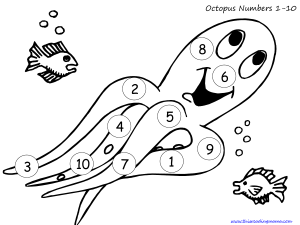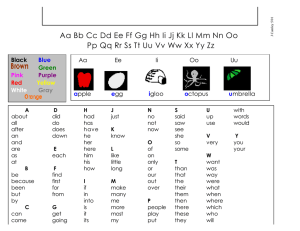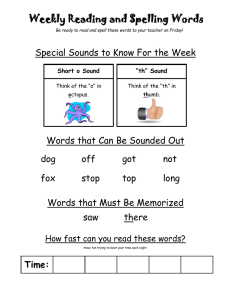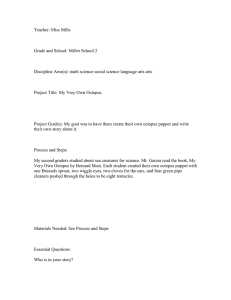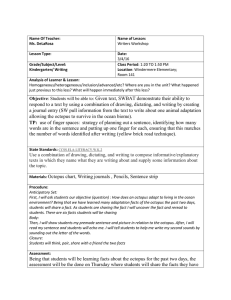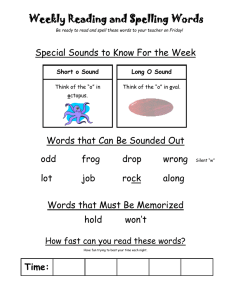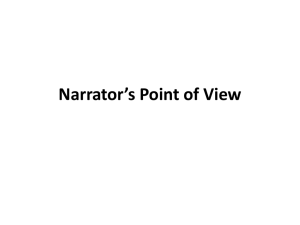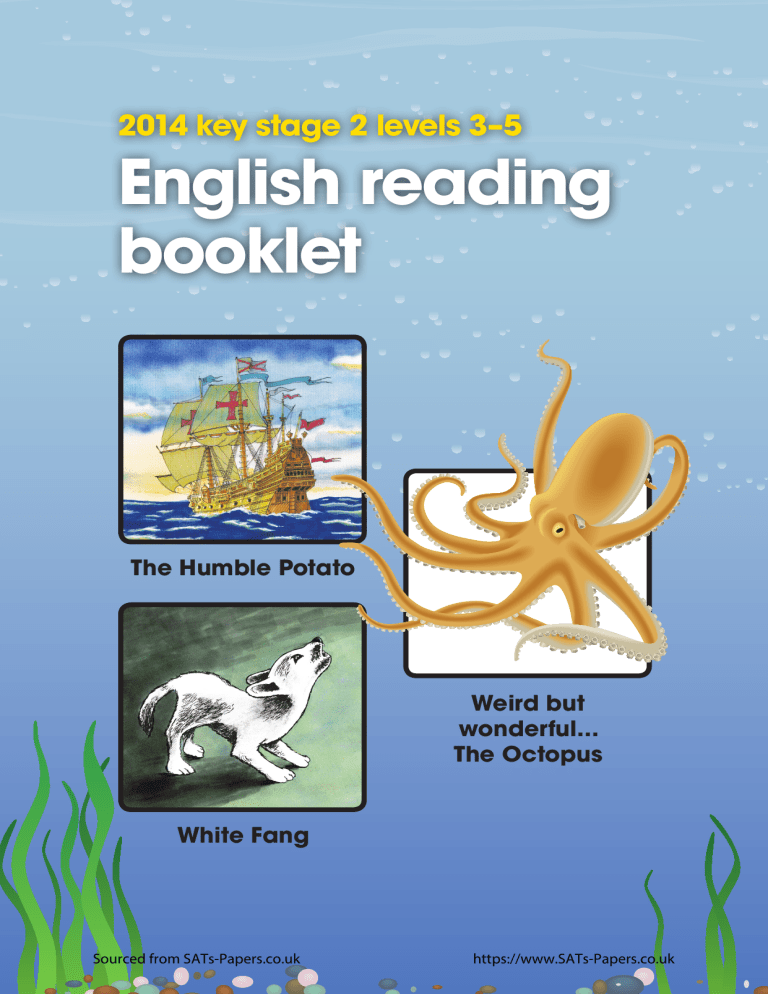
2014 key stage 2 levels 3–5 English reading booklet The Humble Potato Weird but wonderful... The Octopus White Fang Sourced from SATs-Papers.co.uk https://www.SATs-Papers.co.uk 2 Sourced from SATs-Papers.co.uk https://www.SATs-Papers.co.uk Contents The Humble Potato pages 4–5 Weird but wonderful... The Octopus pages 6–9 White Fang pages 10–11 Sourced from SATs-Papers.co.uk https://www.SATs-Papers.co.uk 3 The Humble Potato Where it all began Potatoes were first grown for food in South America thousands of years ago. People found a way to preserve them by leaving them out at night in the cold and then warming them in the sun the following day. During the day, the potatoes were crushed by stamping on them. After doing this for five days, ‘chuno’ (a potato pulp) was made which could be stored and kept for up to ten years in case crops failed. In 1532 Spanish traders, who had been searching for gold, brought potatoes back from South America and used them on board ships as food. It was not long before farmers in Spain began to grow what they called ‘patatas’ and the potato spread across the rest of Europe. They were regarded with suspicion, however, and many people thought they weren’t suitable for humans to eat, partly because of their odd shape. In some places, they were grown just as food for animals. How the potato arrived in Britain There are different opinions about how the potato came to Britain in the late 1500s. One view is that Spanish fishermen ate potatoes on their fishing trips to the North Sea. On their way home, they would land in Ireland to put salt on the cod they had caught to stop it rotting. It is believed that the sailors gave some of their potatoes to the farmers who grew them in the rich Irish soil. Another view is that Sir Walter Raleigh, an explorer who went to the Americas many times, brought Sir Walter Raleigh potatoes back to his Irish farm and planted them there. It is said that he gave a potato plant to Queen Elizabeth I as a gift, and to celebrate, a royal feast was held to eat the potatoes. Legend has it that the cooks threw away the potatoes and instead served up the boiled stems and leaves (which are poisonous). This made everyone very ill and potatoes were then banned from the royal menu. 4 Sourced from SATs-Papers.co.uk https://www.SATs-Papers.co.uk Potatoes today – good to eat and good to grow! Potatoes are very popular today and, despite what some people think, they are also good for you. A baked potato contains a surprisingly large amount of vitamin C – and more fibre than two slices of wholemeal bread. Potatoes also provide carbohydrates and other important nutrients like vitamin B6. They are low in fat too, provided you don’t fry them or add lots of butter! Potatoes are easy to grow. This makes them a perfect crop for farmers in the developing world, who can grow a nutritious food in poor soil. There are plenty of different varieties to choose from and they usually produce a good harvest. Grow Your Own Potatoes Project In 2005 the Grow Your Own Potatoes Project was started. It was one of the first projects to encourage primary schools to grow their own food. Since then it has become the largest of its kind, with almost 1 million children taking part by 2010. In 2011 the winning school had a child on frost watch at the end of every school day and if there was a chance of frost at night they brought their pots of potatoes indoors. No wonder they were winners! Potato facts British people are the third largest consumers of potatoes in Europe. The potato was the first vegetable to be grown in space. Potatoes can be converted into fuel for cars. One of the largest potatoes ever grown weighed in at 3.2 kilograms – the weight of a small dog! Sourced from SATs-Papers.co.uk https://www.SATs-Papers.co.uk 5 Weird but wonderful... The Octopus An amazing body Octopuses are boneless animals and because of this, their bodies are extremely flexible, allowing them to squeeze through small spaces. To swim, an octopus squirts jets of water through a tube called a siphon. The force of these jets is powerful enough to move the octopus quickly through the water. The octopus travels backwards with its eight tentacles trailing behind it. These tentacles have suction cups, or suckers, with sensors that enable them to ‘taste’ whatever they touch. Pupil Head Siphon Large eyes Eight tentacles, each with two rows of suction cups on the underside 6 Sourced from SATs-Papers.co.uk https://www.SATs-Papers.co.uk Octopuses have the largest brains of any invertebrate (an animal that does not have a backbone). They can learn and invent solutions to problems. Captive octopuses have been observed to play, repeatedly releasing bottles or toys into a circular current in their tanks and then catching them again. Octopuses often escape from their tanks in search of food and sometimes even break into the tanks of other creatures. They have also been known to board fishing boats and open the cargo hold to eat crabs. The way the octopus’s nervous system is organised means that only part of it is in the brain. The majority of an octopus’s nerve cells are actually in its tentacles. This has some curious results: when an octopus’s tentacle is cut off, it will crawl away on its own. But that’s not all. If this tentacle meets a food item, it will seize it and try to pass it to where the mouth would have been if it was still connected to the body. Sourced from SATs-Papers.co.uk https://www.SATs-Papers.co.uk 7 Part of body How many Tentacle 8 Catches and chokes prey The underside of each tentacle is covered in 240 suckers. That means an octopus has a total of 1,920 suckers. Heart 3 Pumps blood The blood that each heart pumps is blue. Eye 2 Sees prey and predators, even in low light The pupils remain horizontal even if the octopus turns on its side or upside down. What it does Weird but wonderful Defence and attack Octopuses have a number of different ways to defend themselves. They have a well-developed ability to hide. For example, the common octopus is able to camouflage itself by changing its skin to match the colours, patterns and even textures of its surroundings. Predators such as sharks, eels and dolphins swim by without even noticing it. When an octopus is discovered, it releases a cloud of black ink. This blocks the predator’s view, giving the octopus time to escape. The ink also contains a substance that can reduce the predator’s ability to smell, making the fleeing octopus even harder to track. If necessary, an octopus can squeeze into tiny cracks and crevices where predators can’t reach it. If all else fails, an octopus can lose a tentacle to escape a predator’s grasp and re-grow it later. 8 Sourced from SATs-Papers.co.uk https://www.SATs-Papers.co.uk Invertebrate imitators An octopus in a German zoo learned to open jars of shrimps by copying zoo staff. The octopus, named Frida, opened the jars by pressing her whole body onto the lid and grasping the sides with her eight tentacles. She unscrewed the lid by repeatedly twisting her body. It took Frida anything from ten seconds to an hour to get a lid off, depending on how tightly it had been screwed on. Octopus facts Type of animal Invertebrate (no backbone) Diet Carnivore: crabs, crayfish, shellfish Average lifespan in the wild 1 to 3 years Largest octopus Giant Pacific Octopus Weighs up to 70kg (close to the weight of an average person) Measures 7.5m from tentacle tip to tentacle tip Smallest octopus Octopus Wolfi Can be as light as 1g (the weight of 1 raisin) Measures 1.5cm in length Venom The tiny Blue-ringed Octopus of Australia is the only octopus that has venom deadly to humans. Sourced from SATs-Papers.co.uk Size of a common octopus relative to an average man https://www.SATs-Papers.co.uk 9 This is an extract from ‘White Fang’, a novel by Jack London, written in 1906. It is set in the wild regions of Canada and is about a young wolf cub who comes across a group of men. White Fang The cub came upon them suddenly. It was his own fault. He had been careless. He had left the cave and run down to the stream to drink. It might have been that he took no notice because he was heavy with sleep. And his carelessness might have been due to the familiarity of the trail to the pool. He had travelled it often, and nothing had ever happened before. He went down past the blasted pine, crossed the open space, and trotted in amongst the trees. Then, at the same instant, he saw and smelt. Before him, sitting silently on their haunches, were five live things, the like of which he had never seen before. But at the sight of him the five men did not spring to their feet, nor show their teeth, nor snarl. They did not move, but sat there, silent and ominous. Nor did the cub move. Every instinct of his nature would have impelled him to dash wildly away, had there not suddenly arisen in him another instinct. A great awe descended upon him. He was overwhelmed by his own sense of weakness and littleness. Here was mastery and power, something far and away beyond him. The cub had never seen man, yet deep within him was the knowledge of his ancestors, the eyes that had circled in the darkness around countless winter camp-fires, and peered from safe distances at the strange, two-legged animal that was lord over living things. Had he been full-grown, he would have run away. As it was, he cowered down in a paralysis of fear, already half offering the surrender that his kind had made from the first time a wolf came in to sit by man’s fire and be made warm. 10 Sourced from SATs-Papers.co.uk https://www.SATs-Papers.co.uk One of the men arose and walked over to him and stooped above him. The cub cowered closer to the ground. It was the unknown, revealed at last, in flesh and blood, bending over him and reaching down to seize hold of him. His hair bristled involuntarily; his lips writhed back and his little fangs were bared. The hand, poised like doom above him, hesitated, and the man spoke laughing, “WABAM WABISCA IP PIT TAH.” (“Look! The white fangs!”) The other men laughed loudly, and urged the man on to pick up the cub. As the hand descended closer and closer he experienced two great impulsions - to yield and to fight. The resulting action was a compromise. He did both. He yielded till the hand almost touched him. Then he fought, his teeth flashing in a snap that sank them into the hand. The next moment he received a clout alongside the head that knocked him over on his side. Then all fight fled out of him. His puppyhood and the instinct of submission took charge of him. He sat up on his haunches and howled. The four men laughed more loudly, while even the man who had been bitten began to laugh. They surrounded the cub and laughed at him, while he wailed out his terror and his hurt. In the midst of it, he heard something. The men heard it too. But the cub knew what it was, and with a last, long wail that had in it more of triumph than grief, he ceased his noise and waited for the coming of his mother, of his ferocious mother who fought all things and was never afraid. She was snarling as she ran. She had heard the cry of her cub and was dashing to save him. Sourced from SATs-Papers.co.uk https://www.SATs-Papers.co.uk 11 2014 key stage 2 levels 3–5 English reading booklet Print version product code: STA/14/7023/p ISBN: 978-1-78315-102-8 Electronic PDF product code: STA/14/7023/e ISBN: 978-1-78315-117-2 © Crown copyright and Crown information 2014 Re-use of Crown copyright and Crown information in test materials Subject to the exceptions listed below, the test materials on this website are Crown copyright or Crown information and you may re-use them (not including logos) free of charge in any format or medium in accordance with the terms of the Open Government Licence v2.0 which can be found on the National Archive website and accessed via the following link: www.nationalarchives.gov.uk/doc/open-government-licence/version/2. Exceptions - third party copyright content in test materials You must obtain permission from the relevant copyright owners, as listed in the ‘2014 key stage 2 test materials copyright report’, for re-use of any third party copyright content which we have identified in the test materials, as listed below. Alternatively you should remove the unlicensed third party copyright content and/or replace it with appropriately licensed material. Third party content ‘White Fang’ an extract from ‘White Fang’ by Jack London, Puffin Books 1999. These texts have been incorporated into this test paper solely for the purposes of the examination in accordance with Section 32(3) of the Copyright, Designs and Patents Act 1988. No copyright clearance for any other use has been obtained or sought. If you have any queries regarding these test materials contact the national curriculum assessments helpline on 0300 303 3013 or email assessments@education.gov.uk. Sourced from SATs-Papers.co.uk https://www.SATs-Papers.co.uk
